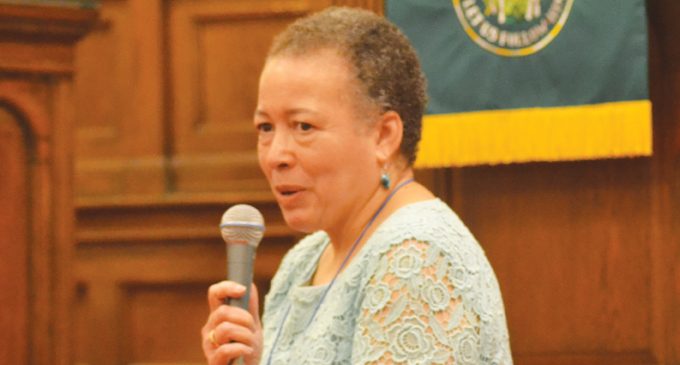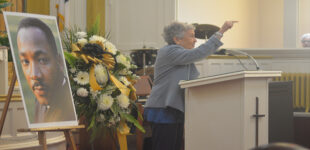Author says engage all students
Photo by Tevin Stinson

In 1997, Dr. Beverly Daniel Tatum released her groundbreaking book “Why Are All the Black Kids Sitting Together in The Cafeteria?” In the original version of the book, Tatum, a former college president, uses her own real-life experiences as a parent and an educator to examine some of the most prevalent issues in American education and race relations, including the need for African-American students to see themselves in the curriculum, and how racial attitudes can negatively affect minority student achievement.
It’s no secret that since the book was released a lot has changed in the United States. In 1997 the nation was at peace with an expanding economy. Today the nation is at war with a lot of economic anxiety and a culture of 140-character communication, which makes dialogue much harder.
But, Dr. Tatum believes, having important conversations on race can still bring about positive change, which is why she has decided to release a revised version of her book to bring people together and take a closer look at race relations just like it did two decades ago.
According to Tatum, the revised version includes new data and information that shows how the education system has changed and/or stayed the same over the years.
“When I wrote it 20 years ago, I wrote it with the hope of giving people tools for understanding what racism is and how racism impacts all of us and how we see ourselves and others, and ultimately how we can use and understand identity development to build bridges across lines of difference,” Tatum said. “That was my goal 20 years ago and I would say today that is still my goal. I still believe the book can bring about positive action and interrupt the cycle of racism.”
Dr. Tatum’s book tour to promote the book began last weekend at the Bookmarks Festival of Books and Authors in Winston-Salem. During an exclusive interview with The Chronicle, Tatum said the revised version focuses more on millennials and their views of the world. She said today we live in a much more diverse society but one thing that hasn’t changed is the segregation of neighborhoods and schools.
“There was a period of school desegregation between 1970 and 1990. Since 1990 up to today schools have been re-segregating. You could say that public schools are more segregated today than they were 20 years ago.” Tatum said.
When asking parents about diversity in schools, Tatum said while most people prefer to send their children to diverse schools, many don’t want to drive out of their neighborhoods to do so. She said findings from a survey done by LR Education Organization shows while 75 percent of parents said diversity in schools was a good thing, they also said they didn’t want to drive out of their neighborhood to find it.
“In this same survey only 25 percent of parents said they were willing to drive a further distance to get their kids in a school that was more racially diverse. So the answer to school diversity is neighborhood diversity but we still find there is a lot of residential segregation,” said Tatum. “Some of that has to do with economics but also there’s still a lot of practices that encourage racial segregation at the neighborhood level so as long as you have neighborhood segregation in today’s reality you’re going to have school segregation.”
While busing students to schools outside of their neighborhoods, and the development of magnet schools have made great strides in bringing students together, recent Supreme Court decisions have made it hard to do that. In 2007, it was ruled that you could not take race into consideration when making school assignments. Tatum said with court decisions like that it’s impossible to ensure schools are diverse, which is one of the main reasons why black students are still sitting together in the cafeteria.
She said, “The Supreme Court said for grades K through 12 you aren’t allowed to take race into consideration so a lot of districts have found that programs they used to use to help desegregate they are no longer able to use for fear of running foul with the law.”
As a retired educator Tatum said although there are more lucrative opportunities available, she is a firm believer that more people of color are going back into the classroom, which could make a huge impact in diversifying schools and help students of color reach their full potential. Before retiring in 2015 Tatum served as president of Spellman College for 13 years. She said close to half of the recruits for organizations like Teach for America are college students of color.
“I lift up that statistic to say I know there are some people who are interested in getting in the classroom and we need that talent,” said Tatum. “In my book one of the things I talk about is regardless of racial membership there’re certain things every teacher needs to understand about the students he or she is teaching and the need for affirmation.
“I often talk about the ABC’s. ‘A’ stands for affirming identity. ‘B’ stands for building community, and ‘C’ stands for cultivating relationship. Every teacher regardless of what they look like should know how to affirm the identities of all the students in the classroom and certain students don’t always get that affirmation. We have to make sure that all students feel engaged with the learning process.”
Following an open panel of authors discussing race, at Calvary Moravian Church, Dr. Tatum held a book signing event to meet with some of her fans eager to read the revised copy of the book.
















